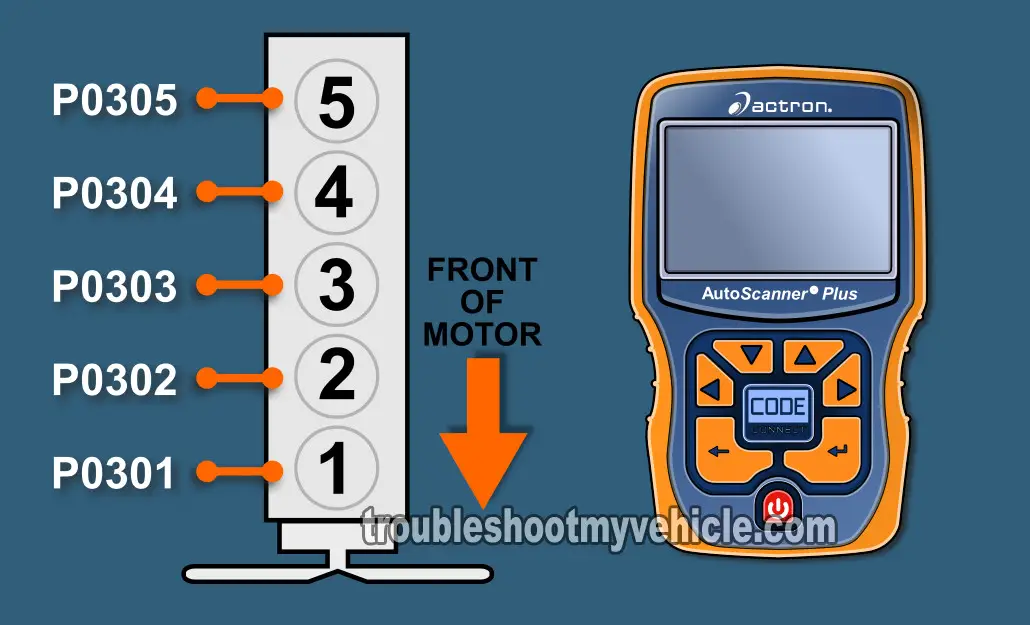Common Causes Of A Misfire Diagnostic Trouble Code (DTC)
Before you start your testing, let me make you aware of the most common causes of misfire codes/conditions on the 3.5L 5 cylinder and 4.2L 6 cylinder engine:
- Bad COP ignition coil.
- A bad COP coil will cause a specific misfire code like P0301, P0302, P0303, P0304, P0305, P0306.
- Leaking intake manifold gaskets.
- The intake manifold gaskets are made out of rubber (they're oversized rubber O-rings) and over time they hardened and shrink which causes them to loose their sealing ability and usually causing a Random Misfire Code P0300.
- Leaking valve cover gasket.
- A leaking valve cover gasket will let engine oil into the spark plug well and inundate the spark plug and coil boot with engine oil.
- This will eventually lead to carbon tracks on the spark plug and coil boot that'll cause a misfire.
- Incorrectly gapped spark plugs.
- Broken spark plug. Specifically, a cracked porcelain insulator.
- Water in the spark plug wells caused by washing the engine.
TEST 1: Checking For Misfire Codes

The very first thing you need to do, is to connect your scan tool to your vehicle and check for misfire codes.
Why? Because the misfire code will help you in identifying which cylinder is the one that could have a bad ignition coil and knowing which ignition coil to test is half the diagnostic battle.
Now, if you don't have a scan tool, you can still use the info in this tutorial but you'll need to do a cylinder balance test. For more info on this, go to: TEST 4: Cylinder Balance Test.
Choose from one of the cases below:
CASE 1: You have a misfire code. The next step is to find out if this misfire code is being caused by a bad COP ignition coil. Go to: TEST 2: Check The Ignition Coil For Spark.
CASE 2: You have a P0300 Misfire Code. This means that whatever is causing the misfire condition, is affecting all of the engine cylinders and not just one.
This code, the (P0300) usually rules out a bad COP ignition coil as the culprit. For more info on troubleshooting a P0300, go to: TEST 5: Most Common Cause Of A P0300.
CASE 3: You DO NOT have any misfire codes. This means that the rough idle that you're experiencing in your vehicle is not being caused by a bad COP coil.
Now, unfortunately, this is not an absolute truth because you could have a bad COP coil. What I suggest you do, is to do a cylinder balance test (TEST 4) and/or a thorough visual inspection of the spark plugs, COP coils to see if:
- Spark plugs are not:
- Soaked in oil (leaking valve cover gasket).
- Soaked in water (from power washing the engine).
- Cracked or broken.
- Center electrode's gap is filled/covered with Carbon (from the cylinder burning oil).
- COP coils are not:
- Soaked in oil (leaking valve cover gasket).
- Soaked in water (from power washing the engine).
- Cracked or broken.
If all of the above checks out then I would suggest an engine compression test. You can find the test here: How To Check Engine Compression (GM 3.5L, 4.2L).
TEST 2: Check The Ignition Coil For Spark

The very first thing you need to do, is check to see if the COP ignition coil is sparking or not.
My instructions below call for an HEI spark tester and if you don't have one, you may be wondering if you can use any other type of spark tester.
And the answer is yes you can use any type of spark tester you want or have. The main reason I use and recommend the HEI spark tester is because this bad boy is accurate (and you don't have to worry about interpreting the color of the spark).
OK, to get your COP ignition coil diagnostic going, this is what you need to do:
- Remove the ignition coil from its place on the valve cover.
- Connect an HEI spark tester to the ignition coil.
- Ground the HEI spark tester with a battery jump start cable directly on the battery negative (-) terminal.
- When everything is set up, have a helper crank the engine while you observe the spark tester.
- The spark tester will do one of two things: spark or not spark.
Let's take a look at your test results:
CASE 1: You got spark. This tells you that ignition coil is OK.
So, if you have a misfire code for the specific engine cylinder this COP coil belongs to then you need to look at the following things:
- Oil dripping onto the spark plug and COP coil boot from the valve cover gasket.
- Spark plugs for carbon tracks.
- Low engine compression in this cylinder.
CASE 2: You DID NOT get spark. This usually means that the COP ignition coil is bad but there's one more thing that you need to do (to make sure that the COP coil is truly defective).
And this is to make sure that the COP ignition coil that did not spark is getting all three signals from its connector. We can easily accomplish this by simply swapping a good and sparking COP coil in place of the one that's not sparking and repeating this test. For this test, go to: TEST 3: Swap The ‘No Spark’ COP Coil.
